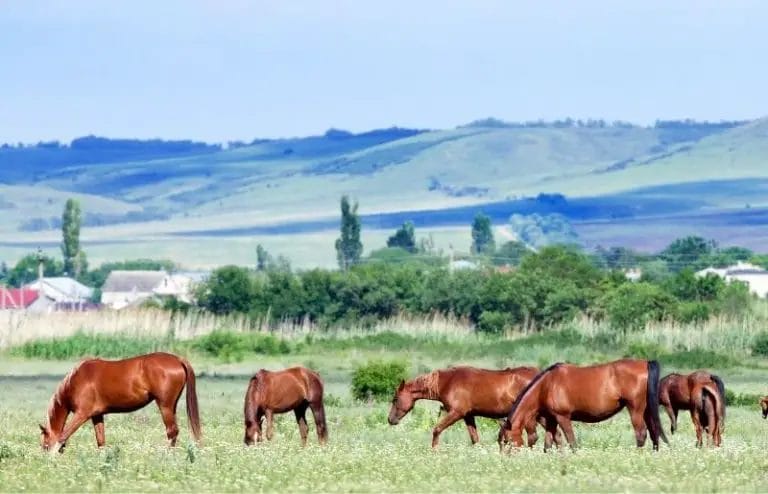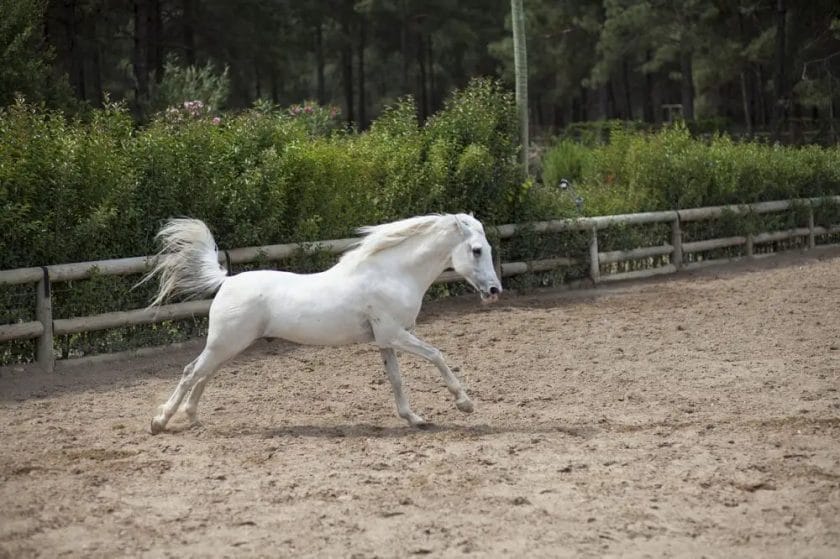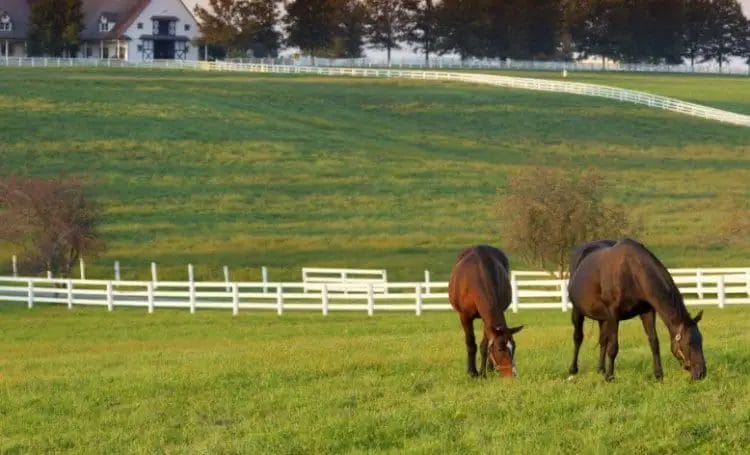In Texas, the number of horses per acre can vary depending on various factors such as land quality, management practices, and local regulations. However, a commonly used guideline is to have 1-2 horses per acre of land. This allows for adequate grazing space and minimizes the risk of overgrazing. It’s important to consider the specific needs of the horses, the type of forage available, and the overall management plan when determining the appropriate number of horses per acre.

Factors Affecting Horse Population Density in Texas: Climate, Pasture Conditions, and Regulations
In this section, we will explore the various factors that contribute to the population density of horses in Texas. Understanding these factors is crucial for horse owners, breeders, and policymakers to make informed decisions regarding the management and conservation of horse populations in the state.
1. Climate
The climate of Texas plays a significant role in determining the horse population density in the region. Texas is known for its diverse climate, with varying temperatures and precipitation patterns across different regions. This diversity impacts the availability of suitable grazing land and the overall health and well-being of horses.
In the northern parts of Texas, where the climate is relatively cooler, horses are more commonly found due to favorable forage conditions. These areas receive a higher amount of rainfall, providing ample grazing opportunities for horses. On the other hand, the southern regions of Texas experience hotter and drier conditions, which can limit the availability of suitable pastureland for horses.
It is important to consider the climatic conditions while planning for horse populations in Texas. Adequate shelter, access to water, and proper nutrition must be provided to ensure the welfare of horses, especially during extreme weather events.
2. Pasture Conditions
The quality and availability of pastureland are essential factors in determining the horse population density in Texas. The state offers a wide range of pasture conditions, including native grasslands, improved pastures, and cultivated forage crops.
Native grasslands, such as those found in the Hill Country region, provide natural grazing opportunities for horses. These areas offer a variety of grasses and plants that support the nutritional needs of horses. However, the carrying capacity of these native grasslands may vary depending on factors such as soil fertility, water availability, and grazing management practices.
Improved pastures, which are cultivated to provide higher-quality forage, can support a higher horse population density. These pastures often consist of specialized grass species and may require additional management practices, such as fertilization and rotational grazing, to maintain optimal conditions for horses.
Availability of cultivated forage crops, such as alfalfa and hay, also contributes to the horse population density in Texas. These crops serve as essential sources of nutrition, especially during periods of limited grazing opportunities due to climatic or pasture conditions.
3. Regulations
Regulations and policies related to horse ownership and management also influence the population density of horses in Texas. These regulations aim to ensure the welfare of horses, prevent the spread of diseases, and manage the impact of horse populations on the environment.
In Texas, certain counties may have zoning regulations that restrict horse ownership or limit the number of horses allowed per acre of land. These regulations are often in place to prevent overcrowding, protect natural resources, and maintain public safety.
Additionally, Texas has regulations regarding equine health, including mandatory vaccinations and testing for diseases. These measures help control the spread of contagious diseases and protect the overall health and well-being of the horse population.
It is crucial for horse owners and breeders to be aware of the regulations in their specific area and comply with them. This not only ensures legal compliance but also contributes to responsible horse ownership and management practices.
Summary
The population density of horses in Texas is influenced by several factors, including climate, pasture conditions, and regulations. The diverse climate of Texas impacts the availability of suitable grazing land, with some regions experiencing more favorable conditions than others. Pasture conditions, including native grasslands, improved pastures, and cultivated forage crops, play a significant role in supporting horse populations. Additionally, regulations related to horse ownership and management aim to ensure the welfare of horses and manage the impact on the environment. Understanding and considering these factors is crucial for effective horse population management and conservation in Texas.

Sustainable Horsekeeping Practices: Maintaining an Appropriate Horse-to-Acreage Ratio in Texas
In the state of Texas, where horse ownership is popular, it is crucial to implement sustainable horsekeeping practices to ensure the well-being of the horses and the preservation of the land. One important aspect of sustainable horsekeeping is maintaining an appropriate horse-to-acreage ratio. This ratio determines how many horses can be properly accommodated on a given amount of land.
When determining the horse-to-acreage ratio, several factors should be taken into consideration. These include the size and quality of the land, the availability of forage, and the climate of the area. In Texas, where the climate can vary from region to region, it is important to adapt the ratio to the specific environmental conditions.
One common guideline for determining the horse-to-acreage ratio is based on the concept of stocking rate. Stocking rate refers to the number of animals that a piece of land can support in terms of available forage and other resources. The specific stocking rate can vary depending on the type of forage and the climate conditions in a particular area.
In Texas, a general recommendation for horse pasture is to maintain a stocking rate of 1-2 acres per horse. However, this can vary depending on factors such as the quality of the forage, the level of management, and the specific needs of the horses. It is important to assess the carrying capacity of the land and adjust the horse-to-acreage ratio accordingly.
In addition to the recommended stocking rate, it is essential to practice rotational grazing. Rotational grazing involves dividing the pasture into smaller paddocks and rotating the horses between these paddocks. This allows the land to rest and recover from grazing, promotes healthier pasture growth, and prevents overgrazing and soil erosion.
Implementing sustainable horsekeeping practices also involves proper manure management. Horse manure can have a significant impact on soil fertility and water quality if not managed correctly. It is important to establish a manure management plan that includes regular removal of manure from the pasture, proper composting or disposal, and avoidance of manure runoff into water sources.
Furthermore, providing adequate shelter, clean water sources, and appropriate nutrition are essential for maintaining the health and well-being of horses. Proper pasture maintenance, including regular mowing and weed control, can also contribute to sustainable horsekeeping practices.
In summary, maintaining an appropriate horse-to-acreage ratio is crucial for sustainable horsekeeping practices in Texas. By considering factors such as land size, forage availability, and climate conditions, horse owners can determine the ideal stocking rate for their pastures. Implementing rotational grazing, proper manure management, and providing adequate shelter and nutrition further contribute to sustainable horsekeeping. By adopting these practices, horse owners can ensure the welfare of their horses and the preservation of the land for future generations.

Managing Grazing Areas: Strategies for Maximizing Horse Health and Land Productivity in Texas
As a horse owner in Texas, it is essential to have effective strategies for managing grazing areas to ensure the health and well-being of your horses as well as maximize the productivity of your land. Proper management of grazing areas not only benefits the horses but also helps in preserving the quality of the soil and vegetation. In this section, we will discuss some key strategies for managing grazing areas in Texas.
1. Rotational Grazing
Rotational grazing is a technique that involves dividing the grazing area into smaller sections or paddocks and rotating the horses between these sections. This strategy allows for better utilization of the available forage and prevents overgrazing in one specific area. By rotating the horses, you give the grazed areas time to recover and regrow, ensuring a continuous supply of nutritious forage for the horses.
When implementing rotational grazing, it’s important to monitor the number of horses in each section to prevent overgrazing. The size of each paddock should be determined based on the number of horses and the available forage. Regularly rotating the horses will help maintain a balanced diet for them and prevent soil erosion and degradation of the land.
2. Rest and Recovery Periods
Allowing grazing areas to rest and recover is crucial for maintaining the health of the land and promoting the growth of nutritious forage. Some areas may need longer recovery periods, while others may recover more quickly. Understanding the specific needs of your land and monitoring the growth of vegetation will help determine appropriate rest and recovery periods.
During the rest and recovery periods, horses should be moved to alternative grazing areas or provided with supplemental feed to meet their nutritional needs. This not only helps preserve the quality of the land but also prevents overgrazing and reduces the risk of soil erosion.
3. Proper Grazing Density
Maintaining an appropriate grazing density is essential for both horse health and land productivity. Overcrowding can lead to overgrazing, nutrient depletion, and increased risk of disease transmission among horses. Conversely, underutilization of grazing areas can result in excessive forage growth, which may lead to wastage and reduced land productivity.
It is recommended to have a target stocking rate that considers factors such as the size of the grazing area, available forage, and the nutritional requirements of the horses. Regular monitoring of the grazing areas and adjusting the horse population accordingly will help maintain an optimal grazing density.
4. Weed and Pest Control
Weeds and pests can have a detrimental impact on the health of the horses and the productivity of the land. Implementing effective weed and pest control measures is crucial to maintaining a healthy grazing environment.
Regularly inspect the grazing areas for signs of weed infestation and take appropriate actions such as mowing, hand-weeding, or using herbicides as necessary. Preventive measures such as proper manure management and regular pasture maintenance can also help control pests and reduce the risk of disease transmission.
5. Water Management
Proper water management is vital for horse health and the overall productivity of the land. Ensure that there is a reliable source of clean and fresh water accessible to the horses at all times. Regularly check water sources and provide adequate water storage to meet the needs of the horses throughout the year.
In addition to providing water, it is important to manage the drainage in the grazing areas to prevent waterlogging and soil erosion. Properly designed water troughs, drainage ditches, and runoff control measures can help maintain a healthy grazing environment.
6. Monitoring and Regular Maintenance
Regular monitoring and maintenance of the grazing areas are essential for effective management. Keep a close eye on the condition of the land, including soil quality, vegetation growth, and signs of erosion or overgrazing.
Implementing regular maintenance practices such as fertilization, reseeding, and soil testing can help improve the productivity of the land and ensure a healthy grazing environment for the horses.
Summary
Effective management of grazing areas is crucial for maximizing horse health and land productivity in Texas. Strategies such as rotational grazing, rest and recovery periods, proper grazing density, weed and pest control, water management, and regular monitoring and maintenance are key to achieving these goals.
By implementing these strategies, horse owners in Texas can ensure the well-being of their horses while preserving the quality of the land for long-term sustainability.
Best Practices for Horse Owners: Balancing Horse Numbers and Acreage for Optimal Land Use in Texas
Horse ownership is a rewarding experience, but it comes with the responsibility of providing adequate space for your equine companions to thrive. Whether you own a few horses for personal pleasure or run a professional boarding facility, finding the right balance between horse numbers and acreage is essential for optimal land use. In the state of Texas, where horse culture and equestrian activities are prevalent, this balance becomes even more crucial. This article will discuss the best practices that horse owners in Texas should follow to ensure the well-being of their horses and the sustainable use of their land.
1. Understanding the Equine Unit
Before delving into the specifics of horse numbers and acreage, it is important to understand the concept of an Equine Unit (EU). An EU is a standard measure used to determine the grazing needs and land requirements for a horse. In Texas, one EU is typically considered equivalent to one horse. However, factors such as the horse’s age, breed, size, activity level, and the quality of the forage available can influence the actual number of EUs that can be sustained on a given acreage.
2. Assessing Acreage Requirements
The amount of land required per horse varies depending on several factors, including climate, soil conditions, and the availability of forage. It is generally recommended to have a minimum of 1-2 acres of pasture per horse in Texas. However, this requirement may increase in regions with limited rainfall or poor soil quality. It is crucial to consider the carrying capacity of your land, which refers to the maximum number of horses that can be sustained without causing overgrazing or soil degradation. Consulting with an agricultural extension agent or a local equine professional can help you determine the specific acreage requirements for your area.
3. Rotational Grazing
Implementing a rotational grazing system can significantly improve land use efficiency and forage productivity. Rotational grazing involves dividing the pasture into smaller paddocks and rotating the horses between them. This allows the land to rest and recover, preventing overgrazing and promoting healthy regrowth of the forage. It also helps distribute manure more evenly, reducing the risk of parasite infestation and nutrient runoff. Rotational grazing requires careful planning, fencing, and monitoring of forage conditions, but it can lead to better land utilization and healthier horses.
4. Supplementing with Hay and Feed
In addition to pasture, horses may require supplemental feeding with hay and concentrates, especially during droughts or when pasture quality is insufficient to meet their nutritional needs. It is essential to have a suitable storage area for hay and feed to ensure their quality and prevent wastage. Proper feeding practices, based on the specific requirements of each horse, should be followed to maintain their health and prevent weight fluctuations.
5. Manure Management
Proper manure management is crucial for maintaining a healthy environment and preventing water pollution. Implementing a manure management plan, which includes regular removal of manure from paddocks and pastures, composting, or spreading manure in a controlled manner, can help minimize the negative impact on the land and nearby water sources. Composting manure can also provide a valuable source of organic fertilizer for your property.
6. Considerations for Facility Design
When designing or renovating a horse facility, careful planning should be done to optimize land use. This includes creating efficient layouts for paddocks, barns, and other infrastructure to maximize space utilization and minimize the distance horses need to travel for feeding and watering. Adequate drainage systems should be in place to prevent soil erosion and waterlogging, ensuring the well-being of both horses and the land.
7. Regular Monitoring and Adjustments
Monitoring the condition of your pastures, the body condition of your horses, and the overall health of your land is essential. Regularly assess the quality and quantity of forage available, check for signs of overgrazing, and adjust the number of horses or the acreage allocated accordingly. Conducting soil tests can provide valuable information about nutrient levels and help you maintain optimal soil fertility. By staying attentive and proactive, you can ensure the long-term sustainability of your land and the well-being of your horses.
Summary
As a horse owner in Texas, it is crucial to find the right balance between horse numbers and acreage to ensure optimal land use. Understanding the concept of an Equine Unit (EU) and assessing the acreage requirements based on factors such as climate, soil conditions,
FAQs
1. How many horses per acre are recommended in Texas?
The recommended number of horses per acre in Texas can vary depending on factors such as soil quality, grazing management, and access to supplemental feed. However, a general guideline often suggested is to have 1-2 horses per acre of pasture.
2. Can I have more horses per acre if I provide additional feed?
Providing additional feed can help support a higher number of horses per acre, but it’s important to consider the availability of grazing and the overall health of the pasture. It is crucial to consult with a local extension office or equine specialist to determine the appropriate number of horses per acre based on your specific circumstances.
3. What considerations should be taken into account when determining the number of horses per acre?
When determining the number of horses per acre, factors such as soil type, grass species, rainfall, parasite control, and pasture rotation should be considered. It’s also important to assess the quality and availability of forage, as well as the overall health and activity levels of the horses.
Conclusion:
In conclusion, when it comes to determining the number of horses per acre in Texas, it is essential to consider several factors such as the type of land, availability of forage, and overall management practices. While there is no one-size-fits-all answer, a general guideline suggests that one horse requires approximately two acres of grazing land. However, the specific needs of each horse and the quality of the pasture should be taken into account to ensure their well-being. It is advisable to consult with local agricultural authorities or equine specialists for accurate and tailored recommendations regarding horse stocking rates in Texas.
